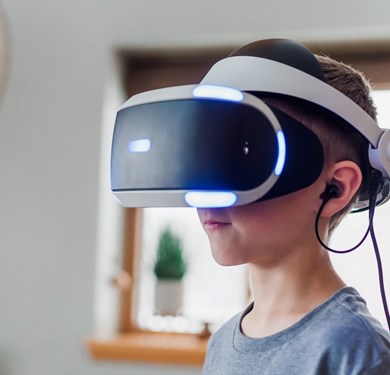There are opportunities to use AR to enhance learning spanning the entire National Curriculum. One of the most common uses of AR in the classroom is in exploring 3D models such as the planets in our solar system, famous landmarks like the Houses of Parliament or the intricate structure of a World War 1 trench. Pupils point their device cameras at a marker on the table and a model will appear virtually in the space in front of them. They are then able to interact with the model by rotating it, zooming in and travelling through it. These models upgrade the experience for the students from simply looking at images or videos and also the need for physical models, which can be expensive and difficult to acquire.
One of the main sources of AR resources in recent years has been Google Expeditions, a smartphone and tablet app which provides a catalogue of over 100 different AR models. Unfortunately, Google Expeditions is being shut down on 30June 2021 but, according to Google, the “majority” of these models will migrate over to Google Arts and Culture (an app and website). Google Arts and Culture currently offers a new addition to the AR catalogue - augmented selfies. Through it’s mobile app, students can adorn themselves with historical articles of clothing, transform themselves into famous artworks (including Self-portait by Van Gogh) and turn the room into an art gallery. The AR resources available on Google Arts and Culture at the time of writing are currently exclusively art related, but expect there to be an increase over the next few months as Google continues to develop the app and retire Expeditions for good.
Another great source of AR resources comes from Twinkl, a company best known for classroom display materials and schemes of work. Twinkl has developed a collection of augmented reality apps for smartphones and tablets around a wide range of topics. Their main AR app, Twinkl LeARn & Explore, allows pupils to explore a variety of simple and dynamic 3D models, some of which are even animated. Twinkl has added an additional layer of interactivity by including labelling activities and writing prompts. This takes AR from being a supplementary resource to a more prominent part of the learning within a lesson.
As teachers, when deciding how to implement technology (like AR) into our classrooms, we have to consider the impact it will have on learning. There’s no doubt that exploring models in augmented reality is fun, and we certainly want our students to enjoy themselves in our lessons. But AR is more than just a novelty. The added benefit of using AR is that it increases engagement, fuels curiosity and promotes collaboration. The ability to explore objects in detail makes AR an excellent resource for exploring historical artefacts and buildings in a way that can’t be matched by images, videos or models.
What stands in the way of using AR successfully is the reliance of organisations like Google or Twinkl, to create the content that would be beneficial to learning. For now, augmented reality resources are still in development and readily available, but just like VR, the popularity of AR goes through cycles and that can mean excellent resources getting retired (like Google Expeditions). Thankfully, the devices schools can use to access AR in classrooms are not made obsolete by changes in ARs popularity, so won’t end up gathering dust in the ICT cupboard if the popularity of AR wanes again.











